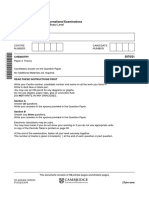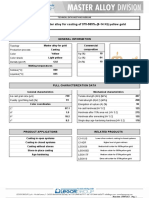08jul201510075310 Akhilesh Kumar Singh 57-62 PDF
08jul201510075310 Akhilesh Kumar Singh 57-62 PDF
Uploaded by
arjun prajapatiCopyright:
Available Formats
08jul201510075310 Akhilesh Kumar Singh 57-62 PDF
08jul201510075310 Akhilesh Kumar Singh 57-62 PDF
Uploaded by
arjun prajapatiOriginal Title
Copyright
Available Formats
Share this document
Did you find this document useful?
Is this content inappropriate?
Copyright:
Available Formats
08jul201510075310 Akhilesh Kumar Singh 57-62 PDF
08jul201510075310 Akhilesh Kumar Singh 57-62 PDF
Uploaded by
arjun prajapatiCopyright:
Available Formats
Journal of Material Science and Mechanical Engineering (JMSME)
Print ISSN: 2393-9095; Online ISSN: 2393-9109; Volume 2, Number 8; April-June, 2015 pp. 57-62
© Krishi Sanskriti Publications
http://www.krishisanskriti.org/jmsme.html
A Study on Effect of Preheating and Post Weld
Heat Treatment (PWHT) of Grade P91 Steel
Akhilesh Kumar Singh1, Tapas Debnath2, Vidyut Dey3 and Ram Naresh Rai4
1,2,3,4
Department of Production Engineering National Institute of Technology, Agartala Tripura (w) - 799046, India
E-mail: 1akhileshkr.singh@hotmail.com
cracking of weld[6]. Research attempts have been made to
Abstract—In the present study, bead-on-plate welds were carried understand and minimize its susceptibility to such cracking
out on P91 steel plates using Gas Tungsten Arc Welding (GTAW). regarding that Pre-heat (at 200⁰C) and Post Weld Heat
Experiment is carried out on three control input process parameters Treatment (at 760⁰C for 2 hrs.) is required to ensure that
(current, travel speed and gas flow rate) with pure argon gas,
desired hardness and microstructure are obtained. Heat
without any filler material using autogenous fusion arc
welding(GTAW) to investigate the effect of preheating and post weld treatment operations are necessary to avoid hydrogen retention
heat treatment (PWHT) on 6mm thick plate of grade P91 steel plates cracking problems in this extremely hardenable P91 steel
was used. The responses, weld bead geometry (in terms of bead material [7-8]. The present study shows that heat treatment is
width(BW), depth of penetration(DOP)), weld area(WA), and width not an optional operation in welding of A 387 Grade - P91
of Heat Affected Zone (HAZ) width have been measured with Adobe (plates). It is necessary as it improves the welding properties
Acrobat 9.0 Pro software. The measured weld quality in the form of as well as the microstructures of different weld bead zones.
weld bead geometry which played an important role in determining The study helps to understand and minimize its susceptibility
the input process parameters to analysis the weld structure and size to cracking after proper heat treatment operations. An
of weld bead geometry. It has been found that the pre-heat and post
autogenous (TIG) welding process on bead on plate welding
weld heat treatment effects the microstructure and micro-hardness of
welded specimen. was performed without the use of filler material.
Keywords: Preheat, PWHT, microstructure, micro-hardness. 2. EXPERIMENTS
1. INTRODUCTION Bead on plate welding experiment was performed on Grade P-
91 steel plates on 6 mm thick plate by Tungsten Inert Gas
Grade P91 steel, basically is a Creep Strength – Enhanced (TIG) welding. TIG welding process is generally used to
Ferritic Steel (CSEF) known as the modified 9Cr-1Mo-V, produce high quality weld joints of 9Cr-1Mo steel [9]. The
designated as P91 steel for Plate (A 387/A387M) its Standard chemical composition of Grade P-91 steel plate’s material is
Specification for Pressure Vessel Plates, Alloy Steel, shown in Table 1.
Chromium – Molybdenum [1]. Modified 9Cr-1Mo-V (P91)
steel is widely used in different high temperature components
of power- generating applications such as steam header, steam
pipes, Superheater, Pressure Vessel Plates, reheater and in
process vessels of chemical industries[2]. An advantage of
using P91steel is low thermal expansion, high thermal
conductivity, good stream corrosion resistance and excellent
creep resistance [3-4]. The modified 9Cr-1Mo-V steel plates
extremely hardenable material. However, welded P91 grade
steel components required proper application of heat treatment
because in power- generating industries P91 steels
components are used at a higher steam temperature more than
600⁰C and a steam pressure greater than 35 MPa[5].
Components are reported to show premature creep failure in
the temperature range 600- 650⁰C. Failures occur in the inter
critical heat affected zone (ICHAZ) and coarse grain region of Fig. 1: TIG welding experimental setup
HAZ (CGHAZ) of weld joints, generally known as Type IV
58 Akhilesh Kumar Singh, Tapas Debnath, Vidyut Dey and Ram Naresh Rai
Experiment is carried out on three control input process 3.1 Pre-Heat and PWHT Welding’s
parameters(i.e. current, travel speed and gas flow rate) is
shown in Table 2. For welding, the specimen P91 steel plate In Table (3-4) show the measured dimensions of weld bead
material was cut into size of 100mm x 50mm x 6mm by geometries and bar-graph is also shown in Fig. (3&4) to
abrasive cutter with blade of thickness 1.5 mm was used to cut analysis the weld bead geometry of Pre-Heat and PWHT
the specimens at 1500 rpm. welded dimensions. Fig.3 shows Pre-Heat before welding, the
specimen C2S2G2 as the heights dimensions at bead welds
Two types of welding have been performed on P91 steel plate. (BW), weld area (WA) and width of Heat Affected Zone
First - Before welding preheating. Second - after welding post (HAZ). When current increases penetration dimension is
weld heat treatment (PWHT). In both welding’s the torch decreases toward C1S1G1 to C3S3G3.
fixed and workpiece is controlled by travel-speed machine has
been fabricated to avoid human errors during welding which Fig.4 shows the PWHT after welding, in this welding we
shown in Fig. (1). observed that when current increases WB and WA dimensions
is increases toward C1S1G1 to C3S3G3 and the heights
After welding, the specimens were cut by abrasive cutter then penetration dimensions is found at specimen C2S2G2. In both
grinded. After that polished and etched, using 5% Nital the weld processes, it can be clearly seen from the Fig. (3 and
solution, to reveal the bead geometry on the cross section. The 4) width of the heat affected zones has approximately equal
etched specimens were then photographed using a digital dimensions observed at both the specimens C1S1G1 and
camera, shown in Fig. 2 and 3 which were later used for C2S2G2.
dimension measurement.
Table 1: The chemical composition of material used
Cr M V N2 C Si M P S Ni Al
% o % % % % n % % % %
% %
P91 8.8 0.9 0.2 0.0 0.0 0.3 0.4 0.0 0.0 0.1 0.0
Steel 1 7 4 46 93 2 4 18 07 5 15
Plate
(6 mm
Thickne
ss) (C1S1G1)
Table 2: The Control Input Process Parameters
Sample Welding Current Welding Gas flow rate
No. (A) Time (l/min)
(cm/min)
1 150 15 8
2 200 17.5 10
3 250 25 12
3. RESULTS AND DISCUSSION
To recognize the weld bead geometry, the welded specimens (C2S2G2)
were cut by abrasive cutter then grinded, polished and etched
to reveal the bead geometry on the cross section.
Photographed taken from a digital camera. To recognize the
digital camera pixel intensity and image capture distance of
specimens, we pasted the (1 cm) scale on the specimen to
measure accurate dimension. The responses, dimensions
measurement of weld bead geometry (in terms of bead width,
depth of penetration), weld area, and width of Heat Affected
Zone (HAZ) have been measured with the help of Adobe
Acrobat 9.0 Pro software. Measured data is shown in Table
(3& 4) and Bar-graph shown in Fig. (3&4)
(C3S3G3)
Fig. 2: Etched cross-section of pre-heat
welding showing bead geometry
Journal of Material Science and Mechanical Engineering (JMSME)
Print ISSN: 2393-9095; Online ISSN: 2393-9109; Volume 2, Number 8; April-June, 2015
A Study on Effect of Preheating and Post Weld Heat Treatment (PWHT) of Grade P91 Steel 59
(C1S1G1)
Fig. 3: Show the measured data of Pre-Heat Welding
Table 4: Measured Data of PWHT Welding
Measured Data of PWHT Welding
Sample Width
Width Penetration Area
Number HAZ
(cm) (cm) (cm2) (cm)
C1S1G1 0.469 0.220 0.076 0.097
C2S2G2 0.513 0.286 0.113 0.095
C3S3G3 0.715 0.237 0.119 0.042
(C2S2G2)
(C3S3G3)
Fig. 3: Etched cross-section PWHT welding
showing bead geometry Fig. 4: Show the measured data of PWHT Welding
Table 3: Measured Data of Pre-Heat Welding 3.2 Microstructures after TIG Welding
Measured Data Of Pre-Heat Welding The microstructures of weld bead geometry and Heat Affected
Sample Width Zone (HAZ) have been analysis by optical microscope (Lieca
Width Penetration Area Qwin software). The microstructures of Pre-Heat and PWHT
Number HAZ
(cm) (cm) (cm2) (cm) welding are shown in the Figures. (5-6).
C1S1G1 0.634 0.261 0.1164 0.118
C2S2G2 0.769 0.247 0.133 0.119
Fig.(5) shows the microstructure of Pre-Heat welding(200ᴼC)
C3S3G3 0.661 0.183 0.090 0.109 in which all the welds show ferrite as well as fresh-martensite
like structures observed in weld zone. The microstructure of
coarse grain zone, grain size is larger than the fine grain zone.
Fig. (6) Shows the overall microstructure of P91 steel in which
all the welds show at weld zone we observed delta-ferrite like
structure after PWHT (760ᴼC for 2hrs.). HAZ- including
Journal of Material Science and Mechanical Engineering (JMSME)
Print ISSN: 2393-9095; Online ISSN: 2393-9109; Volume 2, Number 8; April-June, 2015
60 Akhilesh Kumar Singh, Tapas Debnath, Vidyut Dey and Ram Naresh Rai
coarse grain zone and fine grain zone. The microstructure of
coarse grain zone shows martensite like structure [10-12].
The specific microstructure depends on the related thermal
profile generated by a particular welding condition [13].
(b)
(a)
(c)
Fig. 4: The microstructures of PWHT weld:
(b) (a) C1S1G1, (b) C2S2G2 and (c) C3S3G3
After performing the basic operation of welding image
measurement and microstructure the specimen is further used
for micro-hardness to analysis the mechanical properties of
welding parameter and process used.
3.3 Hardening Behaviour
Hardness is the property of a material to resist the plastic
deformation. For hardness measurement - specimen P91 steel
plate material was cut into size of 50mm x 5mm x 6mm by
abrasive cutter with blade then grinded, polished and etched,
(c) using 5% Nital, to reveal the bead geometry on the cross
Fig. 5: The microstructures of Pre-Heat weld: section. Hardness testing was carried out in a straight line 2
mm below and parallel to surface of the base plate with a
(a) C1S1G1, (b) C2S2G2 and (c) C3S3G3 constant load of 1 Kg and dwell time 10 sec. Reading were
taken 0.5 steps through the WZ, HAZ and the part of the base
material. Hardness testing was carried out according to ASTM
designation: E384 – 11, Standard Test Method for Knoop and
Vickers Hardness of Materials [14].
Fig. 7(a) shows hardness profiles across the entire Pre-heat
(200ᴼC) welded specimens. Hardness is taken from weld
centre line distances(mm). In pre-heat welding we observed
that hardness suddenly increases from weld zone toward
CGHAZ where all specimens have higher hardness value and
then decreases toward base metal. Fig. 7(b) shows hardness
profiles across the PWHT (760ᴼC for 2hrs.) weld. Hardness is
(a) higher at weld zone (WZ) region in all specimens and
Journal of Material Science and Mechanical Engineering (JMSME)
Print ISSN: 2393-9095; Online ISSN: 2393-9109; Volume 2, Number 8; April-June, 2015
A Study on Effect of Preheating and Post Weld Heat Treatment (PWHT) of Grade P91 Steel 61
hardness decrease toward the FGHAZ and then slightly operations are necessary to avoid hydrogen retention cracking
increases toward base metal[15-17]. problems or we call Type IV cracking of weld [16]. The more
effect of heat treatments of P91 steel is investigated in a future
study.
REFERENCES
[1] ASTM, Designation: A387/A387M-06a, “Standard Specification
for Pressure Vessel Plates, Alloy Steel, Chromium-
Molybdenum”.
[2] Hasegawa, Y., Ohgami, M., Okamura, Y., Viswanathan, R., and
Nutting (Eds.), J., “Advanced Heat Resistant Steel for Power
Generation”, The University Press, Cambridge, UK (1999), pp.
655–667
[3] Brozda, J., Lomozik, M., and Zeman, M., “A welding of P91
steel to other grades of steel for elevated temperature service”,
Welding International 1998 12(7), pp. 509-518.
[4] Gianferancesco, A. Di., Tassa, O., Matera, S., Cumino, G.,
Viswanathan, R., Nutting (Eds.), J., “Advanced Heat Resistant
Steel for Power Generation”, The University Press, Cambridge,
(a) UK (1999), pp. 622–632
[5] Milovic, L., Manjgo, M., Andelic, N., Milosevic, V., Je;I, Z., and
Dondur, N., “Behaviour of P91 steel simulated HAZ at 600ᴼC”,
15th International Research/Expert Conference “Trends in the
Development of Machinery and Associated Technology” TMT
2011, Prague, Czech Republic, September 2011, pp. 12-18.
[6] Laha, K., Chandravathi, K.S., Parameswaran, P., Rao, K.B.S.,
and Mannan, S.L., “Type IV Cracking in Modified 9Cr-1Mo
Steel Weld Joint”, Met.Mater. Trans.A, 38 (2007), pp.58.
[7] Coleman, K.K., and Newell Jr., W.F., “P91 and Beyond Welding
the new-generation Cr-Mo alloys for high-temperature service”,
Welding Journal, Aug. 2007.
[8] Silwal, B., Li, L., Deceuster, A., and Griffiths, B., “Effect of
post weld heat treatment on the toughness of Heat affected Zone
for Grade 91 steel”, Welding Research, Vol.92, March 2013.
[9] Arunkumar, V., Vasudevan, M., Maduraimuthu, V., and
Muthupandi,V., “Effect of Activated Flux on the Microstructure
and Mechanical Properties of 9Cr-1Mo Steel Weld Joint”
Materials and Manufacturing Processes, Volume 27, Issue 11,
(b) 2012, pp. 1171-1177.
Fig. 7: (a) shows the Pre-Heat welding (200ᴼC) [10] Maduraimuthu, V., Vasudevan, M., Muthupandi,V.,
and (b) PWHT welding (760ᴼC for 2hrs.) Bhaduri,A.K., and Jayakumar, T., “Effect of Activated Flux on
the microstructure, mechanical properties, and residual stresses
4. CONCLUSION of modified 9Cr-1Mo steel weld joint” Metallurgical and
Materials Transactions B, Volume 43B, 2012, pp.123-132.
The effect of Pre-Heat (200ᴼC) and PWHT at 760ᴼC for 2 [11] Arivazhagan, B., Srinivasan, G., Albert, S.K., and Bhaduri,
hours on microstructures, hardness and weld bead geometries A.K., “A study on influence of heat input variation on
with respect to process parameter of TIG weldment without microstructure of reduced activation ferritic martensitic steel
using filler metal was studied. The effect of variation in weld metal produced by GTAW process”, Fusion Engineering
and Design, 86, 2011, pp. 192-197.
welding parameters on hardness of the weld is pronouncedly
visible when welding is done with Pre-Heat and PWHT. In [12] Srinivasan, G., Arivazhagan, B., Albert, S.K., and Bhaduri, A.K.,
“Development of filler wire for welding of reduced activation
both autogenous TIG welding processes mentioned above,
ferritic martensitic steel for India’s test blanket module of
hardness is higher in Pre-Heat welding than PWHT welding. It ITER”, Fusion Engineering and Design, 86, 2011, pp. 446-451.
is found that PWHT could drastically reduce the hardness but [13] Kapustka, N., Conrardy, C., Babu, S., and Albright,C., “Effect of
side by side increases other properties of material. Grade P91 GMAW Process and Material Conditions on DP 780 and TRIP
steel materials have higher hardenability and components are 780 Welds”, Supplement to the Welding Journal, Welding
used at a higher steam temperature more than 600⁰C and a Research, Vol. 87, pages 135-148, June 2008.
steam pressure greater than 35 MPa that why heat treatment
Journal of Material Science and Mechanical Engineering (JMSME)
Print ISSN: 2393-9095; Online ISSN: 2393-9109; Volume 2, Number 8; April-June, 2015
62 Akhilesh Kumar Singh, Tapas Debnath, Vidyut Dey and Ram Naresh Rai
[14] ASTM, Designation: E384 – 11, Standard Test Method for
Knoop and Vickers Hardness of Materials.
[15] P., Daniela, S., Marie, H., Pavlina, U., Josef, “Comparison of
mechanical properties of P91 steel depending on temperature
and annealing time”, COMAT2012 Recent trends in structural
materials, Plzen, Czech Republic, EU,2012.
[16] T., Nattaphon, H., Weerasak, L., Gobboon, “Effect of Postweld
Heat Treatment on microstructures and hardness of TIG
weldment between P22 and P91 steels with Inconel 625 filler
metal ”, Journal of Metals, Materials and Minerals, Vol.21,
No.1, 2011, pp. 93-99.
[17] Vitek, J.M., and Klueh, R. L., “Precipitation Reactions during
the Heat Treatment of Ferritic Steels”, Metallurgical
Transactions A, Vol. 14a, June 1983, pp. 1047-1055.
Journal of Material Science and Mechanical Engineering (JMSME)
Print ISSN: 2393-9095; Online ISSN: 2393-9109; Volume 2, Number 8; April-June, 2015
You might also like
- The Subtle Art of Not Giving a F*ck: A Counterintuitive Approach to Living a Good LifeFrom EverandThe Subtle Art of Not Giving a F*ck: A Counterintuitive Approach to Living a Good LifeRating: 4 out of 5 stars4/5 (6024)
- The Gifts of Imperfection: Let Go of Who You Think You're Supposed to Be and Embrace Who You AreFrom EverandThe Gifts of Imperfection: Let Go of Who You Think You're Supposed to Be and Embrace Who You AreRating: 4 out of 5 stars4/5 (1133)
- Never Split the Difference: Negotiating As If Your Life Depended On ItFrom EverandNever Split the Difference: Negotiating As If Your Life Depended On ItRating: 4.5 out of 5 stars4.5/5 (911)
- Grit: The Power of Passion and PerseveranceFrom EverandGrit: The Power of Passion and PerseveranceRating: 4 out of 5 stars4/5 (628)
- Hidden Figures: The American Dream and the Untold Story of the Black Women Mathematicians Who Helped Win the Space RaceFrom EverandHidden Figures: The American Dream and the Untold Story of the Black Women Mathematicians Who Helped Win the Space RaceRating: 4 out of 5 stars4/5 (938)
- Shoe Dog: A Memoir by the Creator of NikeFrom EverandShoe Dog: A Memoir by the Creator of NikeRating: 4.5 out of 5 stars4.5/5 (548)
- The Hard Thing About Hard Things: Building a Business When There Are No Easy AnswersFrom EverandThe Hard Thing About Hard Things: Building a Business When There Are No Easy AnswersRating: 4.5 out of 5 stars4.5/5 (359)
- Her Body and Other Parties: StoriesFrom EverandHer Body and Other Parties: StoriesRating: 4 out of 5 stars4/5 (831)
- Elon Musk: Tesla, SpaceX, and the Quest for a Fantastic FutureFrom EverandElon Musk: Tesla, SpaceX, and the Quest for a Fantastic FutureRating: 4.5 out of 5 stars4.5/5 (481)
- The Emperor of All Maladies: A Biography of CancerFrom EverandThe Emperor of All Maladies: A Biography of CancerRating: 4.5 out of 5 stars4.5/5 (275)
- The Yellow House: A Memoir (2019 National Book Award Winner)From EverandThe Yellow House: A Memoir (2019 National Book Award Winner)Rating: 4 out of 5 stars4/5 (99)
- The Little Book of Hygge: Danish Secrets to Happy LivingFrom EverandThe Little Book of Hygge: Danish Secrets to Happy LivingRating: 3.5 out of 5 stars3.5/5 (434)
- Devil in the Grove: Thurgood Marshall, the Groveland Boys, and the Dawn of a New AmericaFrom EverandDevil in the Grove: Thurgood Marshall, the Groveland Boys, and the Dawn of a New AmericaRating: 4.5 out of 5 stars4.5/5 (273)
- The World Is Flat 3.0: A Brief History of the Twenty-first CenturyFrom EverandThe World Is Flat 3.0: A Brief History of the Twenty-first CenturyRating: 3.5 out of 5 stars3.5/5 (2283)
- The Sympathizer: A Novel (Pulitzer Prize for Fiction)From EverandThe Sympathizer: A Novel (Pulitzer Prize for Fiction)Rating: 4.5 out of 5 stars4.5/5 (125)
- A Heartbreaking Work Of Staggering Genius: A Memoir Based on a True StoryFrom EverandA Heartbreaking Work Of Staggering Genius: A Memoir Based on a True StoryRating: 3.5 out of 5 stars3.5/5 (233)
- Team of Rivals: The Political Genius of Abraham LincolnFrom EverandTeam of Rivals: The Political Genius of Abraham LincolnRating: 4.5 out of 5 stars4.5/5 (235)
- On Fire: The (Burning) Case for a Green New DealFrom EverandOn Fire: The (Burning) Case for a Green New DealRating: 4 out of 5 stars4/5 (75)
- The Unwinding: An Inner History of the New AmericaFrom EverandThe Unwinding: An Inner History of the New AmericaRating: 4 out of 5 stars4/5 (45)
- Astm E562 PDF Free 15 PDFDocument4 pagesAstm E562 PDF Free 15 PDFarjun prajapatiNo ratings yet
- Quenched and Tempered Steels: Mechanical PropertiesDocument2 pagesQuenched and Tempered Steels: Mechanical Propertiesarjun prajapatiNo ratings yet
- TRD 301 Annex 1 Design PDFDocument14 pagesTRD 301 Annex 1 Design PDFarjun prajapatiNo ratings yet
- ControllingheattreatmentofweldedP91 PDFDocument4 pagesControllingheattreatmentofweldedP91 PDFarjun prajapatiNo ratings yet
- SIQUAL 5736 Steel: Designation by StandardsDocument1 pageSIQUAL 5736 Steel: Designation by Standardsarjun prajapatiNo ratings yet
- Revival of Ramagundam Fertilizer Complex Project: Pipe (CS, SS, As-Seamless)Document54 pagesRevival of Ramagundam Fertilizer Complex Project: Pipe (CS, SS, As-Seamless)arjun prajapatiNo ratings yet
- Metals 10 00099 v2 PDFDocument23 pagesMetals 10 00099 v2 PDFarjun prajapatiNo ratings yet
- The Analys Is of Failure Causes of The Rotor Shaft of Steam TurbinesDocument4 pagesThe Analys Is of Failure Causes of The Rotor Shaft of Steam Turbinesarjun prajapatiNo ratings yet
- Weber Set Nova Stone Tile AdhesiveDocument6 pagesWeber Set Nova Stone Tile AdhesiveArunKumar ChandrasekarNo ratings yet
- List Update 161019 - Promo PartDocument79 pagesList Update 161019 - Promo PartandiadistNo ratings yet
- Design - Part 4 - Job Knowledge 93Document4 pagesDesign - Part 4 - Job Knowledge 93Billy TanNo ratings yet
- 3.2.2.1 Dead LoadDocument10 pages3.2.2.1 Dead LoadNeølie Abello LatúrnasNo ratings yet
- Tempcon Sandwich Panel BrochureDocument10 pagesTempcon Sandwich Panel BrochureskmeshramNo ratings yet
- CONTRACTING OFFICE COMPANY LTD - (CONTRACO) Saudi A 2020-05-31 10-54-23Document68 pagesCONTRACTING OFFICE COMPANY LTD - (CONTRACO) Saudi A 2020-05-31 10-54-23Ramil LazNo ratings yet
- Portland Cement: Product Description PrecautionsDocument1 pagePortland Cement: Product Description PrecautionsDGWNo ratings yet
- Product Description Directions For Use: Surface PreparationDocument1 pageProduct Description Directions For Use: Surface Preparationrajeshji_000No ratings yet
- Hot Process Liquid SoapmakingDocument11 pagesHot Process Liquid SoapmakingPanacea PharmaNo ratings yet
- Glass Sanding Solution Brochure EnglishDocument12 pagesGlass Sanding Solution Brochure EnglishAbir ChoudhuryNo ratings yet
- SEALANTADHESIVE Answer With ReflectionDocument5 pagesSEALANTADHESIVE Answer With ReflectionCharles Vincent PaniamoganNo ratings yet
- Student Design Lab Report Comparison of Different Types of WeldsDocument26 pagesStudent Design Lab Report Comparison of Different Types of WeldsSylvester WafulaNo ratings yet
- STS / Double-Sided STS (Super-Torque Synchronous Belt)Document5 pagesSTS / Double-Sided STS (Super-Torque Synchronous Belt)vietkhamNo ratings yet
- Product Development: The Electric Kettle Case StudyDocument23 pagesProduct Development: The Electric Kettle Case Studya4idNo ratings yet
- Welltest Summary: Pt. Putra Sejati IndomakmurDocument18 pagesWelltest Summary: Pt. Putra Sejati IndomakmurAditya FathurachmanNo ratings yet
- Jotafloor Top Coat AP Guide PDFDocument6 pagesJotafloor Top Coat AP Guide PDFJay Ram DhakalNo ratings yet
- BFC PresentationDocument14 pagesBFC PresentationMarc GrossNo ratings yet
- Welder Coc IIDocument3 pagesWelder Coc IItimketaNo ratings yet
- Student's Name Professor's NameDocument4 pagesStudent's Name Professor's Namemigire kennedyNo ratings yet
- Nice EAF Mass Balance (Old Is Gold)Document16 pagesNice EAF Mass Balance (Old Is Gold)Karthik GuttiNo ratings yet
- Ansi Asme b16Document7 pagesAnsi Asme b16Trung ozinNo ratings yet
- Synthesis and Characterization of PEG Dimethacrylates and Their Hydrogels.Document8 pagesSynthesis and Characterization of PEG Dimethacrylates and Their Hydrogels.SJ TanNo ratings yet
- Iso 3601 5 2015Document11 pagesIso 3601 5 2015joe.sibbald100% (1)
- Tech. Spec. For ConductorDocument26 pagesTech. Spec. For ConductorbinodeNo ratings yet
- كتالوجات قطاعات الوميل M900Document48 pagesكتالوجات قطاعات الوميل M900asegiver asegiverNo ratings yet
- 5070 w16 QP 21Document20 pages5070 w16 QP 21LOLNo ratings yet
- Conventional Power Plants EUDocument137 pagesConventional Power Plants EUMadhusudhan SrinivasanNo ratings yet
- Irc 028-1967Document16 pagesIrc 028-1967kruttika_apNo ratings yet
- Title 14 KT: Master Alloy For Casting of 375-585 (9-14 KT) Yellow GoldDocument2 pagesTitle 14 KT: Master Alloy For Casting of 375-585 (9-14 KT) Yellow GoldTony BrutiglianoNo ratings yet
- MIG Weld Deposition, Submerged Arc WeldingDocument1 pageMIG Weld Deposition, Submerged Arc WeldingLymeParkNo ratings yet














































































